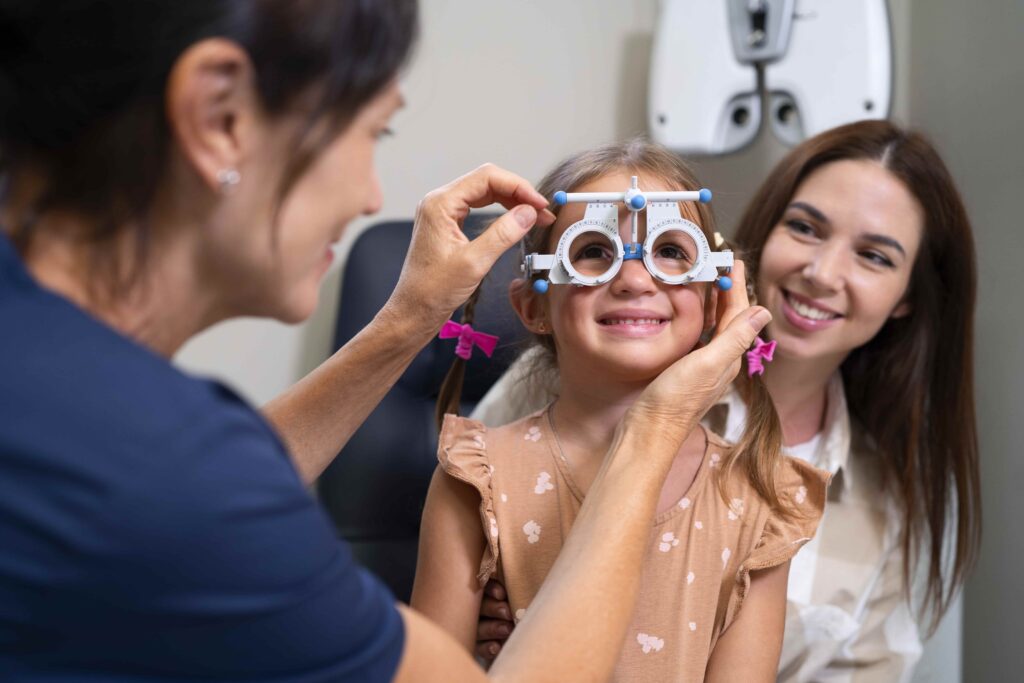As your child heads into a new school year, you’re likely checking off supply lists, organizing schedules, and helping them feel ready and excited. But one important item often gets missed—a comprehensive eye exam.
At Optical Expressions, we want every child to thrive—and healthy vision is a huge part of that. Whether it’s seeing the whiteboard clearly, reading a book without strain, or spotting a ball flying on the playground, eyesight plays a critical role in learning, behavior, and confidence.
2025 Vision Trends in Kids: What Parents Should Know
More Screen Time = More Eye Strain
Kids are spending more time on screens than ever in classrooms and at home. We’re seeing more cases of digital eye fatigue, dryness, and headaches—even in very young children.
Tip: Make the 20-20-20 Rule Fun!
Every 20 minutes, have your child look 20 feet away for 20 seconds. Try these fun ideas:
- Be a Vision Detective: “What’s the farthest thing you can spot?”
- Animal Breaks: “Look like an owl on a tree!”
- Sticker Chart: Reward screen breaks with fun stickers or little surprises
Window Surprise Box: Place small objects or toys far away for them to spot
Common Vision Conditions in Kids
It’s not just blurry vision. Here are some of the most common pediatric eye conditions we check for during exams:
Amblyopia (Lazy Eye)
Amblyopia occurs when one eye doesn’t develop normal vision—often because of a misalignment or a strong prescription difference between the two eyes. The brain favors the stronger eye, limiting the development of the other eye.
What to look for:
- One eye drifting in photos
- Head tilting, squinting, or covering one eye
- Poor depth perception
- Child doesn’t react when one eye is gently covered
Good news: Early detection and treatment (like glasses, patching, or eye drops) are highly effective—especially before age 7–8
Strabismus (Eye Turn or Misalignment)
One eye may turn inward or outward, especially when tired or focusing. This can lead to amblyopia if left untreated.
What to look for:
- Eyes that don’t seem to move together
- Complaints of double vision
- Head tilting or turning to use one eye
Convergence Insufficiency or Tracking Issues
This affects how the eyes work together for close-up tasks like reading. It can cause headaches, skipping lines, or avoiding reading altogether.
What to look for:
- Trouble with reading focus or following lines
- Frequent loss of place or using a finger to track
- Fatigue or frustration with close-up tasks
Refractive Errors: Myopia (nearsightedness), Hyperopia (farsightedness) and Astigmatism
These are the most common and are usually corrected with glasses or contact lenses.
Signs to watch for:
- Squinting or sitting close to screens
- Eye rubbing
- Frequent complaints of blurry vision or headaches
Partner with Teachers, Be Your Child’s Advocate
Teachers often see signs first—difficulty seeing the board, focus issues, or unusual reading habits. Keep communication open and let them know you’re receptive to feedback. You are your child’s best advocate.
When Should Kids Get Eye Exams?

- First exam: 6–12 months old
- Next check: Between ages 3–5
- After that: Every 1–2 years, or sooner if issues arise
At Optical Expressions, our pediatric eye exams are gentle, encouraging, and even fun—designed to meet kids where they are, whether it’s their first visit or their tenth.
The doctors at Optical Expressions specialize in caring for school-aged children. For preschool-aged children or younger, please call our office so we can ensure your child’s appointment is scheduled with the right provider and care approach.
Let’s Set Them Up for a Successful Year
Vision isn’t just about seeing clearly. It’s about feeling confident, connected, and ready to learn. Let’s make sure your child is starting the school year with their best vision forward.
Comments are closed.

